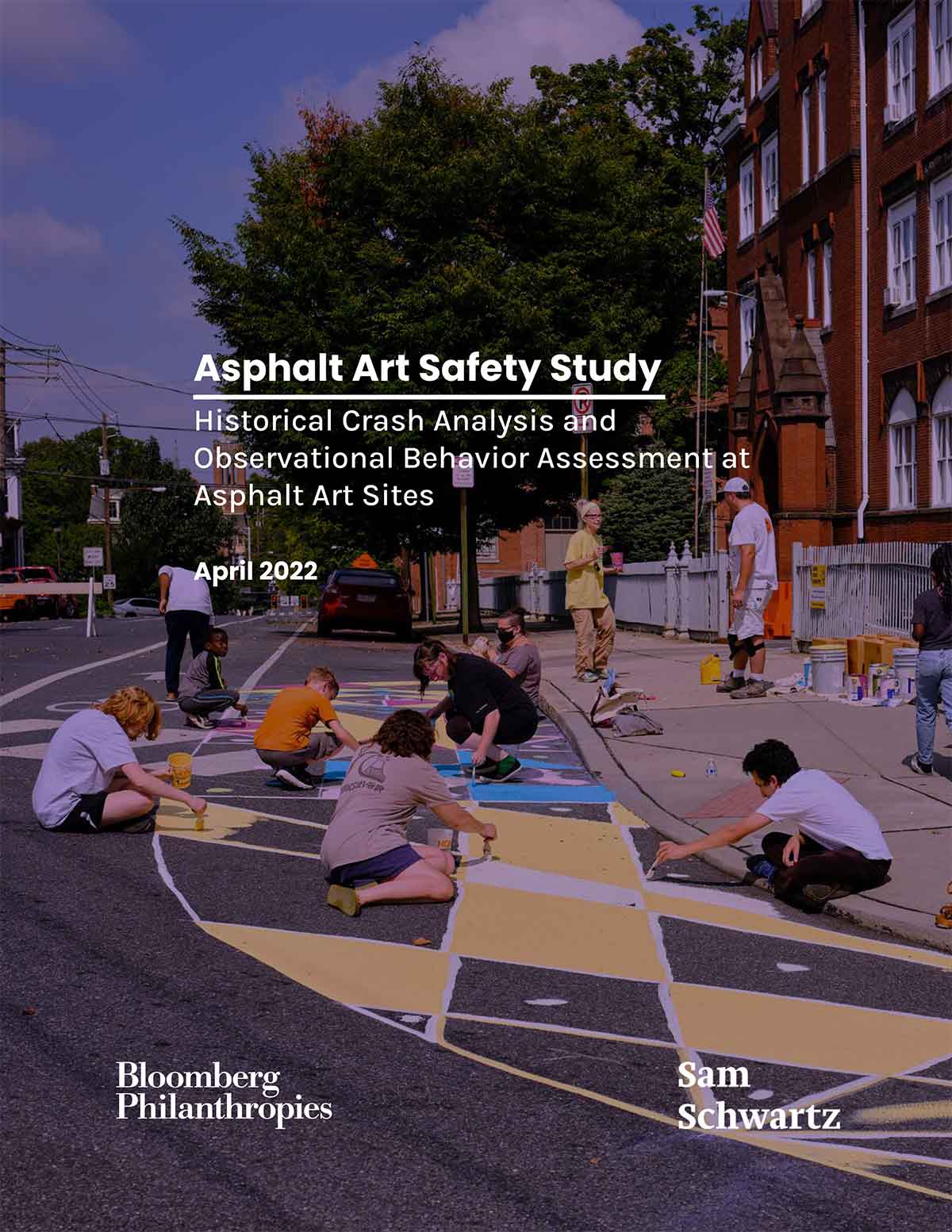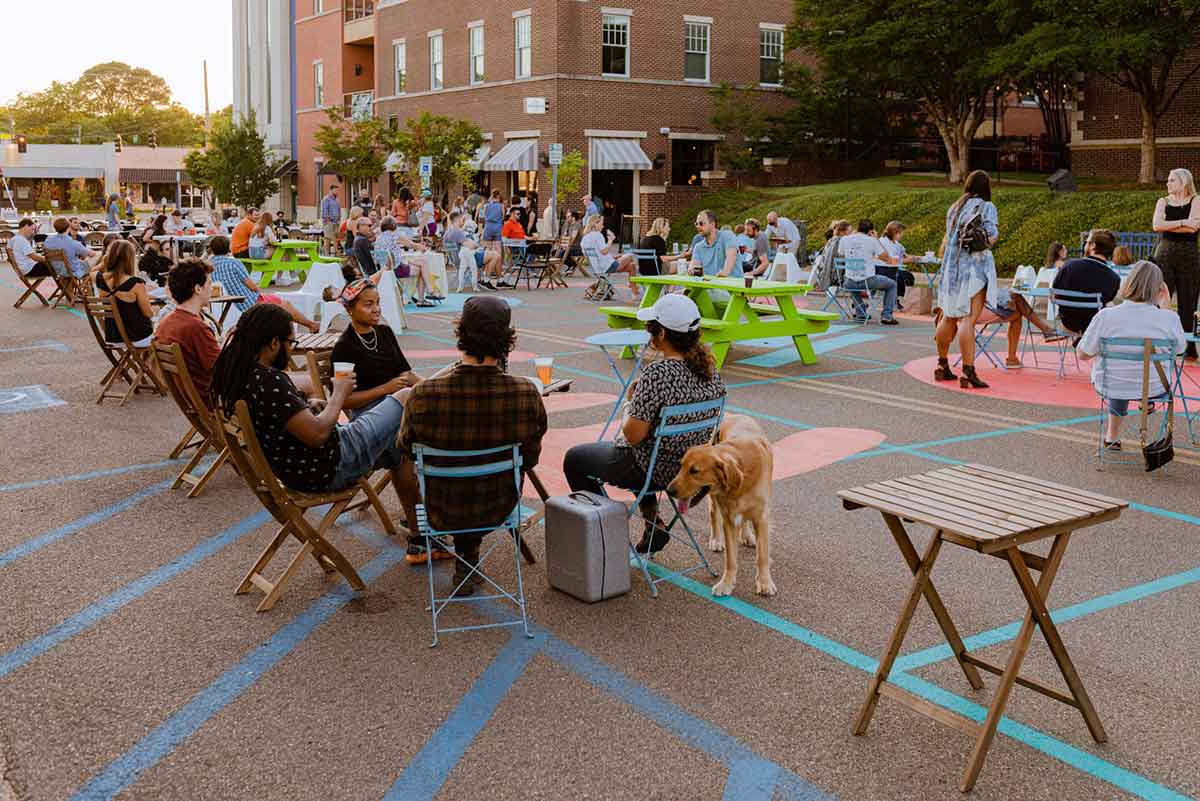It’s pretty safe to assume Michael Bloomberg is a sound financial investor. A pioneer in financial data services, he rose from modest beginnings to become the 13th richest person in the world. That’s why it’s so exciting to us that he prioritizes investing in public art projects through his foundation, Bloomberg Philanthropies. It’s a strategy he uses to help improve life for millions of people in cities around the world. In this article, we’ll show you 5 ways Bloomberg Philanthropies—the organization in charge of all of Michael Bloomberg’s charitable giving—promotes public art, why they do it, and what developers and other commercial real estate professionals can learn from it.
- Michael Bloomberg Witnesses the Power of Public Art
- 1. Creating a Public Arts Data Guide
- 2. The Bloomberg Philanthropies Asphalt Art Initiative
- 3. The Asphalt Art Street Safety Study
- 4. The Bloomberg Philanthropies Public Art Challenge
- 5. An Evaluation of the Bloomberg Philanthropies Public Art Challenge
- Conclusion
- Learn More
Michael Bloomberg Witnesses the Power of Public Art
During his time as mayor of New York City, Michael Bloomberg experienced the power of public art firsthand. “Art could remake streets and improve public safety, inspire people, draw in visitors, and enhance residents’ quality of life. And when we combined our public art projects with our efforts to strengthen city infrastructure through new public plazas or bike lanes, we created even safer, more vibrant streets for everyone,” he says in a publication from Bloomberg Associates, his pro bono consulting firm for cities and mayors.
His charitable foundation Bloomberg Philanthropies considers public art one of their top priorities. So much so that they publish a separate annual report purely on their charitable support of the arts worldwide.
“Art could remake streets and improve public safety, inspire people, draw in visitors, and enhance residents’ quality of life.” — Michael Bloomberg
Of course, being a data services pioneer, Michael Bloomberg is committed to using an evidence-based approach to all his charitable giving. Bloomberg Philanthropies routinely commissions studies of the art projects they fund to see what kind of effect they have on communities. Then they publish those findings and make them accessible to everyone for free.
We looked through their online resources and found a treasure trove of data and inspiration for developers, economic development organizations, and other commercial real estate professionals. Read on for our top five.
1. Creating a Public Arts Data Guide
In 2020, Bloomberg Associates, the philanthropic consulting arm of Bloomberg Philanthropies, published a guide to using public arts data for policy decision making. Arts Data in the Public Sector: Strategies for Local Arts Agencies was inspired by Bloomberg Associates’ years of experience helping client cities leverage cultural sectors into unique and vital elements of their economy, identity, and quality of life.

Why Publish a Guide to Public Arts Data?
Public art can help attract tourism, boost local economies, enhance community identity, and improve quality of life. City governments and other community leaders need data on public art to make informed decisions about arts policies. However, data collection varies from place to place with many communities not having a clear idea of why they collect the data they do. This free, downloadable guide compiles best practices from local arts agencies in 15 cities across the United States, (including our home in Austin, Texas). By showcasing successful examples and addressing common challenges, the guide provides practical strategies for local arts agencies to effectively collect and utilize arts data in their communities.
What Can Developers Learn?
How to work with their local arts agencies and governing bodies to collect and present the right public art data to support their vision for the community.
2. The Bloomberg Philanthropies Asphalt Art Initiative
The Bloomberg Asphalt Art Initiative is a global effort to transform city streets through art and community engagement. The initiative focuses on asphalt art, which includes visual interventions on roadways, pedestrian spaces, and vertical infrastructure like utility boxes and traffic barriers. It aims to improve street safety, revitalize public spaces, and engage residents. Bloomberg Philanthropies has funded 90 projects in North American and European cities through the Asphalt Art Initiative grant program. In addition to grants, the selected cities receive technical consulting in partnership with tactical urbanism firm Street Plans. Bloomberg Philanthropies continues to expand their list of grantees through cities across North America.
Video: Artists and citizens in Reno, Nevada completed an Asphalt Art project that turned an unused, downtown industrial block into a community event space.
Why Does Bloomberg Philanthropies Invest in Asphalt Art?
The initiative was inspired by Mike Bloomberg’s experience revitalizing neighborhoods as mayor of New York City from 2002 to 2013. Under his leadership, New York City transformed 180 acres of roadways into vibrant park plazas by rerouting traffic and creatively repainting streets. Focusing specifically on asphalt art means projects remain relatively low-cost, often short-term, and scalable while creating immediate positive impact and catalyzing long-term improvements to the public realm.
What Can Developers Learn?
Developers can examine case studies and receive practical advice for using art and community engagement to improve street safety and revitalize public spaces in the Asphalt Art Guide: How to Reclaim City Roadways and Public Infrastructure with Art. The free guide was published by Bloomberg Associates and later expanded upon with an asphalt art FAQ page on the Bloomberg Philanthropies website. The FAQ answers questions like, “How can I convince a reluctant city engineer to pursue asphalt art?” and outlines U.S. Design Guidelines on Asphalt Art.
3. The Asphalt Art Street Safety Study
In March 2022, Bloomberg Philanthropies published the Asphalt Art Safety Study in partnership with Sam Schwartz Consulting.

Why Conduct this Study?
Bloomberg Philanthropies recognized that cities wanting to install asphalt art in their communities need data to overcome regulatory hurdles. They funded this study to help with that effort.
What Can Developers Learn?
- The study found there was a 50% reduction in crashes involving pedestrians or cyclists and a 37% decrease in injury-causing accidents after installation of the art.
- Researchers also found a 27% increase in drivers yielding to pedestrians and a 25% reduction in dangerous conflicts between drivers and pedestrians.
Video: Grantees in Kansas City, MO transformed a dangerous intersection into a safer, more beautiful streetscape.
4. The Bloomberg Philanthropies Public Art Challenge
Launched in 2014, the Bloomberg Philanthropies Public Art Challenge asks mayors of US cities with at least 30K citizens to work with the creative sector to develop solutions to significant urban issues. Applicants can win up to $1Million towards the completion of a temporary art installation. Installations must address an urgent civic issue and have the potential for positive impact on the city. Along with the Public Art Challenge grant, each winning city receives technical support from Bloomberg Philanthropies to execute their projects over the next two years.
Video: Bloomberg Philanthropies announces the latest Public Art Challenge grantees and provides a look at past projects.
Here are just a few issues being tackled by Bloomberg Public Art Challenge grantees:
Creating Innovative Public Shade and Cooling in Phoenix, Arizona
Phoenix’s project “¡Sombra! The Celebration of Shade” commissioned 9 artists and teams to design and create innovative shading and cooling installations to combat the city’s extreme urban heat. Lead artists Fausto Fernandez and Maria Salenger will work closely with the selected artists to develop and implement proposed ideas fully. The completed installations will be displayed in various neighborhood parks throughout Phoenix during the summer of 2025, providing much-needed relief and encouraging community interaction amidst record-high temperatures. In the fall of 2025, the installations will be relocated to Steele Indian School Park for a free, one-day festival celebrating the community’s resilience to heat and emphasizing the essential role shade plays in the city.
Supporting Greater Public Activity and Presence with Light Installations
Baltimore’s winning public art project, “Inviting Light,” will incorporate light activations to support greater public activity and presence at the city’s Station North Arts District. Under the direction of artistic lead and curator artist Derrick Adams and lighting designers Flux Studio, artists will develop 5 interventions that consider the specific needs of often overlooked community members, to be implemented in 2025. “Inviting Light” follows a two-year community engagement, planning and prototyping process that sought to understand light’s impact on a sense of comfort and place in the nighttime environment.
Artist & Architect Create a Vision to Combat Urban Blight
The cities of Albany, Schenectady and Troy, New York collaborated as 2015 Public Art Challenge grantees to transform vacant buildings into art by placing pulsing light panels in their windows. The creative vision of artist Adam Frelin and architect Barbara Nelson, the project called Breathing Lights was designed to stimulate dialogue, engage communities, and spark action on the issues of urban blight in the region. More than 90 public and private sector partners worked together to complete the project that culminated with a 2017 regional summit for local residents, prospective buyers and investors, and policymakers. $3.9 million in contributions and in-kind support was raised for blight prevention and mitigation efforts, including a grant from the City of Albany to hire a new vacant building coordinator and a $3.4 million grant from the New York State Attorney General for Land Bank efforts in Albany, Troy and Schenectady.

Images: A street mural installed by Public Art Challenge grantees in Jackson, MS transformed a busy street into an outdoor dining area for local restaurants where residents could gather during COVID-19 social distancing protocols. Photo Credit: Bloomberg Philanthropies
5. An Evaluation of the Bloomberg Philanthropies Public Art Challenge
Bloomberg Philanthropies’ commitment to the evaluation of each Public Art Challenge project they help fund allows us to learn from their efforts. Here are just a few of the findings from past projects.

Image: Bloomberg Philanthropies Public Art Challenge grantees in Camden, NJ transformed illegal dumping sites into public art venues. Their efforts helped raise $55.2M to combat the issue. Photo Credit: Bloomberg Philanthropies
Camden, NJ’s public art project helped raise $55.2 million to combat illegal dumping in the city
Grantees in Camden, New Jersey transformed 6 illegal dumping sites into public art venues to reclaim the public spaces, increase civic pride, and improve perception of the city to the 65,000 people who travel through Camden every day. The increased awareness of the public dumping issue generated by the art program led to significant new investments including:
- $3,500,000 – Federal Brownfield Cleanup Grants from the EPA
- $30,000,000 –State funds for cleanup of blighted spaces
- $21,000,000 – State Department of Transportation Funding
- $500,000 – City funds for safety and security equipment (cameras to stop illegal dumping)
- $200,000 – in new art commissions by the Camden project team
Increased Civic Pride
Across all 2018 grantee cities, 88% of people attending Public Art Challenge activities experienced increased civic pride, 11 percentage points more than attendees at non-Public Art Challenge public art. The impact was most pronounced in Anchorage, Alaska (97% compared to 74%) and Coral Springs/Parkland, Florida (93% compared to 78%).
Increased Foot Traffic
Grantees in Jackson, Mississippi placed public art installations in neighborhoods that had a lack of infrastructure and high vacancies. Foot traffic across three exhibition sites grew six times what it was before the installations, from an average of 80 people per day in the fall of 2019 to 480 people per day in the fall of 2021.
Conclusion
Michael Bloomberg more than believes in the transformative power of public art. He has the data to prove that it enhances community well-being and economic vitality. We hope this list inspires you to invest in public art at your next development project. Art + Artisans can help. We have a vast knowledge of public art procedures and policies and we can help you find the right resources for your project, timeline, budget, and specified surfaces. Contact us to put our skills to work for you.
Learn More About Mike Bloomberg’s Investment in Public Art
- Supporting Public Art [Bloomberg Philanthropies]
- Arts Data in the Public Sector Strategies for local arts agencies [Bloomberg Associates]
- Asphalt Art Guide: How to Reclaim City Roadways and Public Infrastructure with Art [Bloomberg Associates]
- Bloomberg Philanthropies Asphalt Art Grantee Projects [Bloomberg Philanthropies]
- New Study Shows Streets Are Safer with Asphalt Art [Bloomberg Philanthropies]
- Bloomberg Public Art Challenge [Bloomberg Philanthropies]
- Sombra: Innovative Public Art as Shade [Phoenix Office of Arts & Culture]
- Baltimore to Receive $1 Million Bloomberg Philanthropies Grant [The Neighborhood Design Center]
- Breathing Lights: Multi-City Art Installation in Albany, Schenectady, and Troy [Official Website]
- A New View: Transforming Illegal Dumping Lots into Venues for Public Art [Bloomberg Philanthropies]
- Fertile Ground: Improving Access to Healthy Food in Jackson, MS [Bloomberg Philanthropies]


